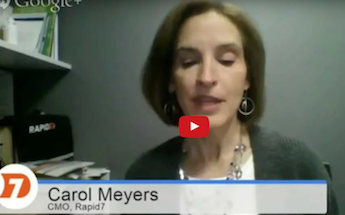
The fourth? interview in our webcast series on The Channel’s Biggest Marketing Challenges? is with? ? Carol Meyers,? CMO at Rapid7.? Carol has? a wealth of experience and insights? on channel management, including branding, lead generation, sales support and partner management. We discuss channel partners challenges from the Supplier perspective, including best practices for partner enablement, channel account management, and developing? effective partnerships.
Just a few of the best points from our conversation with Carol Meyers:
- One of the biggest changes in the channel is the growing number of players needed to integrate complex solutions and bring all the pieces together. In the old days, customers were often looking for monolithic solutions, where now they’re looking for more tailored solutions. So. everyone needs to be a lot savvier? about how all the pieces work together,? which means we need to educate our partners a lot more effectively.
- Just sending out data sheets doesn’t cut it anymore.? We need to provide our channel partners with the same kind of thought leadership capabilities as our own marketing team.
- Linking together lead generation, content creation and social is one of the biggest challenges for channel companies. All? of the technology we’ve been bringing to our sales people to help them be brand ambassadors now has to go to the channel, and somehow integrate? with the tools ? and processes they’re already using.
- Service isn’t about integration so much any more, but about helping customers understand how the product fits into their workflow, and how they can maximize the value of their investment. Service is? more strategic now.
There’s a lot more technology involved in enabling the channel, a lot more information to sift through, but relationships are still? key.
- There’s less concentration of buyer decision-making. There are still just a few people setting budget, so you still have to get to them. But people below senior management are much more empowered to make decisions, because it isn’t such a huge integration process. It’s a lot more nimble. So the audience for solutions decision-making is expanding.
- One thing that hasn’t changed in the channel is the value of relationships. There’s a lot more technology involved in enabling the channel, a lot more information to sift through, but relationships are still? key. So you have to develop relationships not just with senior management, but also with the sales people? at your partner companies. People sell what they’re comfortable with,? so you have to get to know those people and help? them really understand how your product helps their customers.
- Good channel managers are curious. They need to really understand how their channel partners run their business, their culture, how they educate their employees, how they make money. Of course they? need to be business savvy, but they need that curiosity to? really understand their partner’s business so they can tailor their approach to enablement.
- Revenue is of course an important metric for partner performance, but when you’re opening new markets, you have no track record. So you have to look more at how partners run their business: how are they? engaging with their customers, how are they building pipeline, how good are they at getting customers to renew?


Después de los angeles batalla, solo tendrás que dejar caer unas copas y tu
héroe estará de nuevo dispursto para dar guerra, y no te habrá costado nada.
Great reminder. Great article with clear observations and suggestions.
Having worked with many of the F500 in channel management, we noticed that the more successful and profitable (e.g. divisions within GE, DuPont, Sun, Pentax) included their channel partners in the development of marketing collateral, and in sales and marketing training with their direct operations. They also understood that their objective was to make their partners more successful.
One misnomer in this article is that “the channel” is not an entity, it is a route to market. Many companies have multiple channels in which they have multiple business partners (SPs, SIs, Distributors, Resellers, etc.). And there are five basic partner models in distribution. Thus, the support required by the different partners is different based on their business model, role and business focus. Communication, cooperation and integration are essential elements to a richer return for everyone.
Our publications shed greater light on how to better work with partners: “13 Best Practices for Profitable Partnering”, and “Fastest Way to Multiple Your Revenue Objectives: Understand How Your Business Partners Make Their Money and How You Can Help Them – 5 key business models with 11 core attributes” (Amazon)